

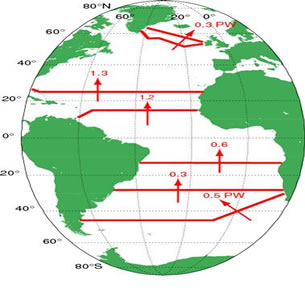
The mechanisms which control the heat transport, nutrient and carbon budgets of the North Atlantic Ocean have yet to be clearly identified, which affects our understanding of how the ocean is warming, phytoplankton grow and how the oceans uptake CO2.
There is a unique opportunity to take these obeservations and combine with data from three already funded cruises in the North Atlantic in 2004/2005 under the RAPID and AMT programmes. The study will include a synthesis of these measurements by developing and applying an inverse model and a coupled biogeochemical, isopycnic circulation model.
At present, there is uncertainty in the estimate of heat transport across
36°N. Previous inverse models of heat transport across 36°N differ
by 0.4 PW, raising questions about the reliability of nutrient transport estimates.
Air-sea heat exchange estimates are ambiguous for the region between 24°N
and 36°N associated with uncertainties in the large heat losses to the
atmosphere over the Gulf Stream.
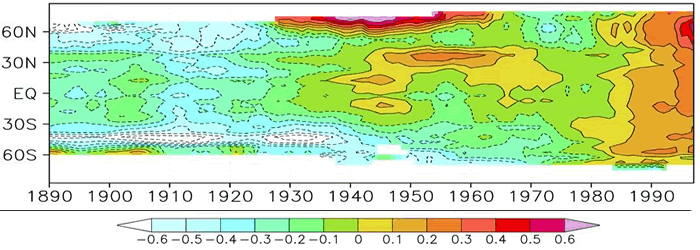
© Recent warming of air temperature (temperature change,
°C from Delworth)
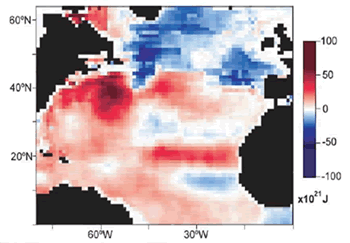
© Diagnosed ocean heat content change (10^21 J) for 20
y periods centred on 1990 annd 1960 (Lozier & Moore, 2003). Note how the
Atlantic Ocean is warming at low and mid latitudes, but cooling at high latitudes.

© Ocean sections measuring the northwards ocean heat flux
(10^15 W = 1 PW)
The proposed new section along 36°N would define the structure of meridional heat transport through the N. Atlantic and help differentiate in the heat loss between 24°N and 36°N implied in the air-sea flux climatologies. The 24°N and 36°N sections showed that the subtropical gyre had warmed since 1957, and reoccupation of the 24°N during WOCE demonstrated continued warming over 35 years. The new 36°N section would help define the structure of decadal changes in water masses within the subtropical N. Atlantic.
At present, it is unclear how the N and P budgets are closed
over the N. Atlantic. Inverse models suggest that there is a loss of nitrate
and phosphate over the mid latitudes of the subtropical gyre. The inverse
models differ in the detail of their predictions, with the loss of nitrate
based on a northwards flux at 36°N and a zero flux at 24°N from one
model, while there is a southwards flux at 24°N from another model. This
implied loss of nitrate and phosphate might be offset by an influx of organic
nutrients. In particular, there might be surface, wind-driven influx of dissolved
organic nitrogen and phosphorus from neighbouring upwelling regions. Alternatively,
atmospheric inputs of N and P might provide a role in closing the budgets.
Nitrogen fixation provides a significant source of N to surface waters, but
there is no equivalent source for P.
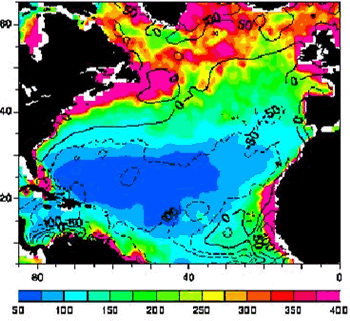
© Satellite based estimates of primary productivity (mol
C m-2 y-1) from Sathyendranath et al. (1995) together
with contours of vertical velocity at 100 m (m/y)
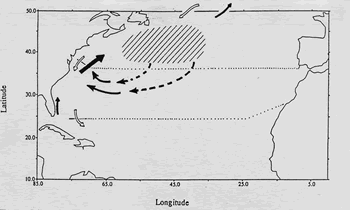
© Schematic of surface northwards nitrate flux (black
full arrow) with deeper southwards return flux. There is an overall loss of
nitrate between 24°N and 36°N. This loss of nitrate may be offset
by an influx of dissolved organic nitrogen (Rintoul & Wunsch, 1991)
It is unclear as to how anthropogenic carbon is transferred
over the N. Atlantic. Coupled carbon and circulation models suggest that the
N. Atlantic should be a sink of anthropogenic C. However, transport studies
at 24°N and in situ estimates of air-sea fluxes suggest that
the N. Atlantic is a source of anthropogenic C (with the partial pressure
of CO2 rising faster in the surface waters of the N. Atlantic than
in the atmosphere). The reason for this contradiction is presently unclear.
A possible factor might be a reduction in convective activity over the region
leading to an increased stratification, increasing C in surface waters and
reducing the subsequent uptake of CO2 from the atmosphere. In common
with N and P, the transport of dissolved organic carbon (DOC) might be important,
possibly sustaining net heterotrophy and controlling the oxygen distribution
over the N. Atlantic.

© Change in partial pressure of carbon dioxide in the
atmosphere and ocean at Hawaii
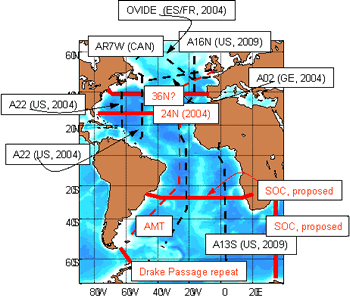
© Proposed ocean sections measuring the transport of carbon